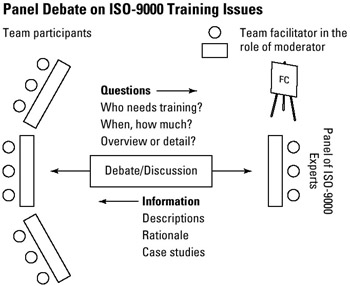Tool 129: Panel Debate
| AKA | N/A |
| Classification | Analyzing/Trending (AT) |
Tool description
A panel debate technique allows a team of panelists with diverse knowledge, experience, or opinions to debate and share their insights on a topic, problem situation, or improvement opportunity. All participants, by questioning, gain valuable and current information to promote a more in-depth understanding of a specific study topic or problem issue.
Typical application
-
To provide access to current information and expertise from internal or external experts.
-
To allow participants to interact with a panel of experts for the purpose of collecting specific information.
-
To consult with people who have been recognized as experts in their field.
Problem-solving phase
| → | Select and define problem or opportunity |
| Identify and analyze causes or potential change | |
| → | Develop and plan possible solutions or change |
| Implement and evaluate solution or change | |
| → | Measure and report solution or change results |
| Recognize and reward team efforts |
Typically used by
| Research/statistics | |
| 3 | Creativity/innovation |
| 4 | Engineering |
| Project management | |
| 5 | Manufacturing |
| 1 | Marketing/sales |
| Administration/documentation | |
| 6 | Servicing/support |
| 2 | Customer/quality metrics |
| Change management |
before
-
Brainstorming
-
Buzz Group
-
Fishbowls
-
Rotating Roles
-
Consensus Decision Making
after
-
Different Point of View
-
Run-It-By
-
Fresh Eye
-
Critical Dialogue
-
Presentation
Notes and key points
-
Limit the size of a panel to 4 to 5 people.
-
Assign a panel moderator to keep the debate moving along.
-
Allow enough time so that key points and all questions (or prepared questions) can be discussed.
Step-by-step procedure
-
STEP 1 The team leader or facilitator contacts and schedules the members of the panel, experts in the field who can greatly contribute to the problem situation the team is presently researching.
-
STEP 2 Participants brainstorm the information that is needed and formulate questions prior to the actual panel debate.
-
STEP 3 The team facilitator, in the role of the moderator, facilitates the introductions and starts the debate/discussion. See example Panel Debate on ISO-9000 Training Issues.
-
STEP 4 A designated recorder records responses and key information during this interaction and date the document.
-
STEP 5 After completion of the panel debate, the team summarizes keypoints, identifies questions left unanswered, and discusses the next steps.
Example of tool application

EAN: 2147483647
Pages: 326